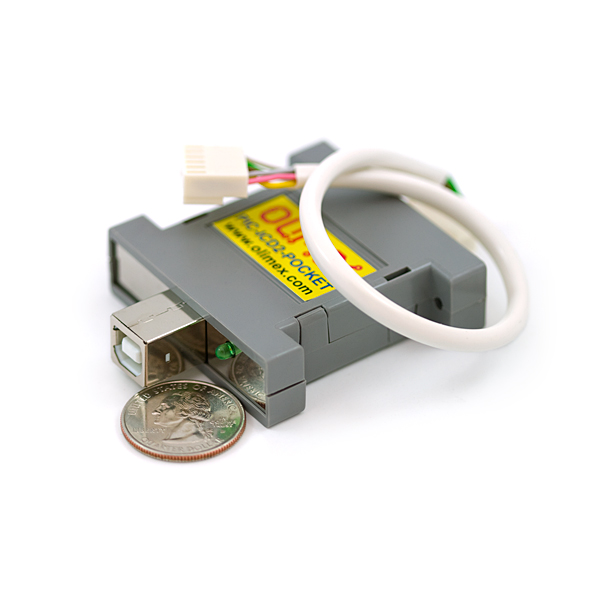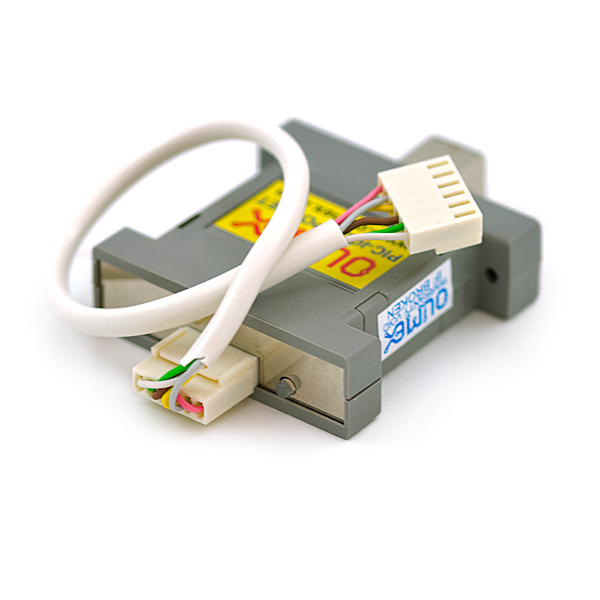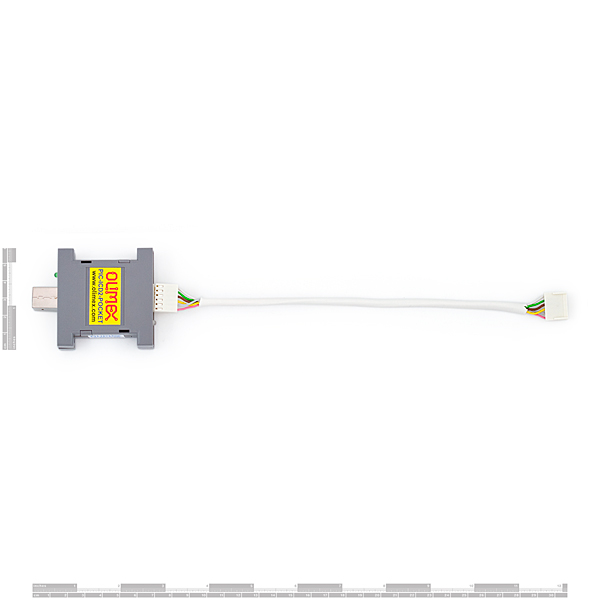MPLAB Compatible ICD2 with USB
Replacement: None. We are no longer carrying this product in our catalog. This page is for reference only.
PIC-ICD2-POCKET is the world's smallest PIC ICD2 debugger and programmer, with only 55 x 55 mm (2.16 x 2.16") dimensions and only 30gr weight (without ICSP cable and packing) this little device fits in your pocket and is very convenient to carry with you when you work in field. PIC-ICD2-POCKET is completely replacement of Microchip's original MPLAB-ICD2 and with it you can do everything you can do with the original MPLAB-ICD2, the only difference is that MPLAB-ICD2 have also RS232 while PIC-ICD2-POCKET operates only from USB. PIC-ICD2-POCKET is a low cost, real-time debugger and programmer for selected PIC® MCUs and dsPIC® DSCs.
Programs can be downloaded, executed in real time and examined in detail with the debug functions of MPLAB. Set watch variables and breakpoints from symbolic labels in C or assembly source code, and single step through C source lines or into assembly code. PIC-ICD2-POCKET can also be used as a development programmer for supported MCUs. The secret behind In Circuit Debugging is two dedicated hardware lines (microcontroller pins used only during debugging mode) that control In Circuit Serial Programming™ (ICSP™) of the device and, afterwards, debugging through proprietary, on-chip firmware. The ICD 2 debug features are built into the microcontroller and activated by programming the debug code into the target processor. There is some shared overhead expense that includes one stack level, some general purpose file registers and a small area of program memory.
FAQ:
Q: What's the difference between PIC-ICD2-POCKET and MPLAB-ICD2 (PIC-ICD2)?
A: There is no functional difference between them - PIC-ICD2-POCKET is 100% compatible to MPLAB-ICD2. The only difference is the ICSP connector - Microchip uses RJ45 phone jack connector, we use 0.1" step. PIC-ICD2-POCKET also have no RS232 connector for connection to PC host, this is obsolete and slow interface and for the sake of miniaturization we decided to cut it from this design.
Q: What USB cable do I need?
A: You can use the very common USB type A-B cable to connect to PC.
Q: What should I know when connect PIC-ICD2-POCKET to target board.
A: It's very important your target PIC MCLR to not be connected directly to VCC! During the programming/debugging MCLR goes as high as 13VDC and if your target MCLR is connected directly to target VCC you will blow either PIC-ICD2-POCKET either your target board. Use always 10K pullup resistor from MCLR to VCC.
Q: I'm on very low budget. What is the difference between PIC-ICD2-POCKET and PIC-ICD2-TINY?
A: There are two major differences between PIC-ICD2-POCKET and PIC-ICD2-TINY: 1. TINY have only RS232 port and works slower than PIC-ICD2-POCKET. TINY have fixed 13VDC Vpp while PIC-ICD2-POCKET have variable voltage Vpp, some new PIC microcontrollers have max limit of 12.5V for Vpp and diode drop circuit should be used if you work with TINY.
- USB (Full Speed 2 M bits/s) interface to host PC
- Real time background debugging
- MPLAB IDE GUI (latest release available for free download from Microchip's web site)
- Built in over-voltage/short circuit monitor
- Firmware upgradeable from PC
- Light plastic enclosure
- Supports low voltage to 2.0 volts. (2.0 to 6.0 range)
- Diagnostic bi-color LED (Busy, Error)
- USB power status green LED
- Reading/Writing memory space and EEDATA areas of target microcontroller
- Programs configuration bits
- Erase of program memory space with verification
- Peripheral freeze-on-halt stops timers at breakpoints
- PIC ICSP connector (top view)
- MPLAB-IDE - download the latest version from Microchip's web site
Comments
Looking for answers to technical questions?
We welcome your comments and suggestions below. However, if you are looking for solutions to technical questions please see our Technical Assistance page.
Customer Reviews
No reviews yet.




So I'm not trying to deter people form buying one of these. I have one and love it, but I only use it with MPLAB 8. Microchip's new version of MPLABX is not guaranteed to support the ICD2. They have publicly stated that they have no plans to add support to MPLABX for the ICD2. http://www.microchip.com/forums/fb.ashx?m=621197 So if you are only going to use MPLAB8, this is still a great tool.
So I have finished my 1284p AVR design. Now I want more beef!!! Anyone know of great tutorials for PICs?
I have the older Olimex ICD2 PGM-00005. Funny if I plug that number in I get the newer version (diff PGM number).
Question is I need drivers for it on Win7 64 bit. Where do I find these?
I cannot get this device to recognize on Mac OSX (latest), despite downloading two different versions of the FTDI drivers (2.2.9, 2.2.10). I suspect it is using a non-FTDI USB chip (System Profiler claims it is a Microchip device, VID 0x4D8).
Is any help available for this problem? The value of the time I have spent on this far exceeds the cost of the device. Without better installation instructions, I would not recommend this to anyone else with a Mac.